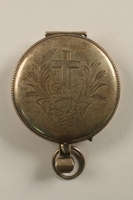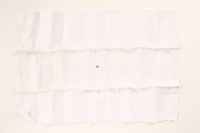Overview
- Brief Narrative
- Satin lined leather burse, or case, used to carry ceremonial items used for Mass by Father Edward Henry, a chaplain in the United States Army in Europe during World War II. A sheet with prayers and the Rite of Eucharistic Devotion from 1964 was later stored in the burse. As a Catholic priest, Father Henry carried a portable Mass kit to administer last rites, to offer communion, and to perform mass for the troops. His unit took part in the liberation of Paris on August 25, 1944. He was one of the first American priests to hold mass in the Cathedral Notre Dame de Paris after liberation.
- Date
-
use:
1944-1945
publication/distribution: 1964
- Geography
-
use:
Paris (France)
- Credit Line
- United States Holocaust Memorial Museum Collection, Gift of the Estate of Edward Henry
- Contributor
-
Subject:
Edward C. Henry
- Biography
-
Edward C. Henry was born in 1912 in Trenton, New Jersey, the youngest of 10 children. He graduated from Our Lady of Angels Seminary at Niagara University in New York. He was ordained to the priesthood on March 13, 1937. He enlisted in the United States Army and served as a chaplain in Texas, England, and France.
On August 25, 1944, Father Henry and his regiment assisted in the liberation of Paris soon after the landings in Normandy that June. In reflecting upon his service as an army chaplain, he noted that "it was hard to get used to," as soldiers "half alive would come in and you try to ease their last moments." He was one of the first American priests to say mass at the Cathedral of Notre Dame post liberation. Father Henry traveled throughout France, performing last rites, saying mass, and administering communion to the troops.
After the war, he returned to New Jersey and led three congregations prior to retiring in 1970. He died in 1999, age 87 years old.
Physical Details
- Language
- English
- Classification
-
Christian Art and Symbolism
- Category
-
Ceremonial containers
- Object Type
-
Burses (corporal) (aat)
- Physical Description
- a. Square, dark brown leather pouch, worn to a light brown, with rounded corners, tooled square outlines, and a gold painted Latin cross pressed on the front and reverse exterior. A gold colored metal zipper with a pull train unzips from left to right along the bottom; the front flap opens upward. The interior is lined in offwhite moire silk. The corners of both flaps have 4 painted pink rosebuds. Each flap has a semi-oval, gathered pocket with a single pleat stitched to the interior lining. On the pleat of the top pocket is a black Latin cross surrounded by offwhite and light brown diagonal lines, above a pink rosebud; to the left and right are pink roses. On the pleat of the bottom pocket, below a black Latin cross, a pink bleeding heart with orange and yellow flames shooting out the top is encircled by thorns; to the left and right are pink roses. A long dark brown cord strap passes through the top of the pouch, under the interior lining. The left upper zipper top stop has engraved English text and a number.
b. Double sided, preprinted sheet of English text and numbers in black and green ink on rectangular, white paper, copyrighted in 1964. One side has a red border, text printed in green ink, and is entitled “DEVOTIONAL PRAYERS”. The body includes 6 prayers: Act of Faith, Act of Hope, Act of Contrition, Prayer to Jesus Crucified, and Prayer to St. Joseph. The reverse is printed in black ink and entitled, “RITE OF EUCHARISTIC DEVOTION”. The body includes 4 rites printed in block lettering: Exposition, Adoration, Benediction, and Reposition. The numbers 3 and 4 are at the top and center of the right edge. All text is bold except for the response to the Benediction. - Dimensions
- a: Height: 4.125 inches (10.478 cm) | Width: 4.375 inches (11.113 cm) | Depth: 0.500 inches (1.27 cm)
b: Height: 8.125 inches (20.638 cm) | Width: 5.375 inches (13.653 cm) - Materials
- a : leather, cloth, metal, cord, thread, paint
b : paper, ink - Inscription
- zipper stop, upper left, engraved : MADE / IN / USA / 21
Rights & Restrictions
- Conditions on Access
- No restrictions on access
- Conditions on Use
- No restrictions on use
Keywords & Subjects
Administrative Notes
- Legal Status
- Permanent Collection
- Provenance
- The burse and prayer sheet were donated to the United States Holocaust Memorial Museum in 2010 by John Grasser and Linda Layton, on behalf of the Estate of Edward Henry.
- Funding Note
- The cataloging of this artifact has been supported by a grant from the Conference on Jewish Material Claims Against Germany.
- Record last modified:
- 2023-08-25 18:26:02
- This page:
- https://collections.ushmm.org/search/catalog/irn43120
Download & Licensing
In-Person Research
- By Appointment
- Request 21 Days in Advance of Visit
- Plan a Research Visit
- Request to See This Object
Contact Us
Also in Edward Henry collection
The collection consists of artifacts and photographs relating to the experiences of Edward Henry, a chaplain in the United States Army during World War II in England and France, where his unit participated in the liberation of Paris.
Date: 1944-1964

Sterling silver communion host pyx engraved with a cross, wheat, and a grape cluster used by a US Army chaplain
Object
Sterling silver, engraved altar bread host used by Father Edward Henry, a chaplain in the United States Army in Europe during World War II. A pyx is a vessel used to transport consecrated communion host. As a Catholic priest, he carried a portable Mass kit to administer last rites, to offer communion, and to perform mass for the troops. Father Henry and his unit took part in the liberation of Paris from Nazi Germany on August 25, 1944. He was one of the first American priests to hold mass in the Cathedral Notre Dame de Paris after liberation.

Sterling silver communion host pyx with the engraved monogram IHS used by a US Army chaplain
Object
Sterling silver altar bread host engraved IHS, a monogram for the name of Jesus Christ (Iesous Christos), used by Father Edward Henry, a chaplain in the United States Army in Europe during World War II. A pyx is a vessel used to transport consecrated communion host. As a Catholic priest, he carried a portable Mass kit to administer last rites, to offer communion, and to perform mass for the troops. Father Henry and his unit took part in the liberation of Paris on August 25, 1944. He was one of the first American priests to hold mass in the Cathedral Notre Dame de Paris after liberation.

Brown leather laced burse with embroidered satin pockets, a purificator, and a small cloth used by a US Army chaplain
Object
Leather burse, or case, with laced side flaps and two pockets, used to carry ceremonial items used for Mass by Father Edward Henry, a chaplain in the United States Army in Europe during World War II. As a Catholic priest, Father Henry carried a portable Mass kit to administer last rites, to offer communion, and to perform mass for the troops. He also carried a purificator, used to wipe the chalice after each use during communion, and the small cloth, which may have been used as a finger towel. A chaplain's Mass kit may include many other items, but it is adapted depending on where it may be used. Father Henry and his unit took part in the liberation of Paris on August 25, 1944. He was one of the first American priests to hold mass in the Cathedral Notre Dame de Paris after liberation.
Edward Henry photographs
Document
Contains photographs illustrating Edward C. Henry's experiences during and after World War II as a Catholic chaplain in the United States Army. Includes black-and-white images depicting his army unit as well as Signal Corps imagery of Buchenwald and Dachau concentration camps shortly after liberation. Also includes numerous images of bomb-damaged towns and cathedrals in France.



